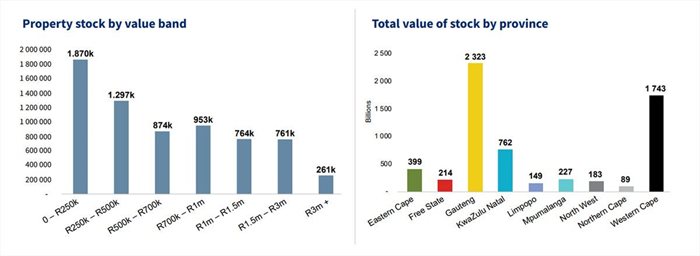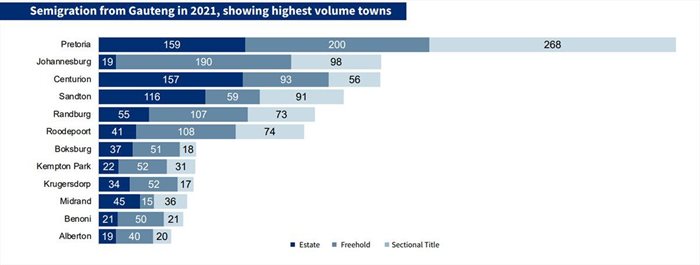#BizTrends2022: A breakdown of the semigration trend in South Africa

Other key findings included:
- Movement to and from small towns like Margate, Mossel Bay, Milnerton and Jeffery’s Bay is on the increase;
- The state of the economy is telling in the number of people downgrading as opposed to upgrading;
- A trend towards estate living in the R1m-R3m market.
Semigration refers to when a buyer sells a property and purchases a new one in a new province. This presentation also assesses who was moving and why.
South Africa’s formal property stock volumes sit at 6.8 million and is valued at R6.1tn. Gauteng accounts for the bulk of the stock (35%) and value (38%), but the demand for properties in the Western Cape is evident in that it accounts for 18% of the stock but 29% of the value. KwaZulu-Natal is next at 13% for both stock and value. In all the other six provinces, the value of the stock is less, in percentage terms, than the total stock volume.
Interestingly, as the graph below shows, properties valued at less than R250k account for 1.870k properties, and those valued at between R250k-R500k number 1.297k – that’s 3.167k or 47% out of a total of just under 6.8 million. Properties under R1m in value number 4,994, or 74% of the total market.
While the bulk of properties sit in the lower price bands, transfers since 2008 have shifted away from properties in the under R500k band – which was then the leading category – to properties in the R1m-R3m band, the leading category since 2018.
The tough economic conditions are hurting the lower price bands more than the mid-market’s R1m-R3m band or the high band of R3m+, which has also increased since 2008.
The table above demonstrates the shift since 2008 – entry-level transfers were the highest at 121,439, and they have dropped to 35,452, now the second lowest category. The R500k-R1m category has also declined, but not as spectacularly, from 72,101 to 53,535. Both the R1m-R3m and >R3m categories have risen.
While the increase in the latter categories is welcome, the decline in the number of transfers under R1m is cause for concern.
Covid-19 affected house prices in different ways – and it was luxury pricing which fell the most, although it has recovered strongly. Low, mid and high value homes are also recovering and the overall market is moving in the upward direction.
Most people are moving to the Western Cape, up to 35% in 2021 from 31% in 2020. The numbers were even higher at 36% in 2016 and 2017. For Gauteng, its declining popularity is evident in this data too. In 2015, 29% of semigrants were moving to Gauteng. This had dropped to 27% in 2020 and to 21% in 2021.
There has been an increase in activity to the Eastern Cape from 7% in 2015 to 9% in 2021, while KwaZulu-Natal has dropped marginally from 14% in 2015 to 13% in 2021. The impact of the civil unrest in KwaZulu-Natal in July this year, if any, has yet to make itself felt in the numbers.
What’s driving semigration?
The trend towards moving from metropolitan areas to smaller and larger towns or Cape Town – South Africa’s second largest metro – can mostly be attributed to a move away from crime-and-grime and towards a slower, safer, quality lifestyle in the small to large towns. Semigrants are also attracted to the fact that municipalities are typically better run in the Western Cape than in other parts of the country.
Most semigrants are leaving Gauteng, and are going to the Western Cape. The two graphs below highlight those leaving, and the high numbers in Gauteng are in stark contrast to the much lower numbers in the Western Cape.
While the numbers of people moving to Gauteng are relatively high, they are less than those leaving. With the Western Cape, it’s the other way around, with more people arriving than leaving (see graphs below).
Most people moving are in the 49-64 age group, and most of that group are moving to the Western Cape. The 36-49 age group makes up the second largest category and again the Western Cape is their preferred destination.
Interestingly, 46% of buyers moving to the Western Cape (graph above) are more likely to move to a new property of greater value and smaller size, while 34% will downgrade size and value and 20% will upgrade size and downgrade value.
Overall (graph below), more people are downgrading (24% in 2015 to 27% in 2021) while less people are upgrading (37% in 2015 to 34% in 2021). Those upgrading had in fact fallen to 33% in 2019 and 2020, and the increase in 2021 might be a result of more people moving into larger homes which offer greater work-from-home flexibility.



































